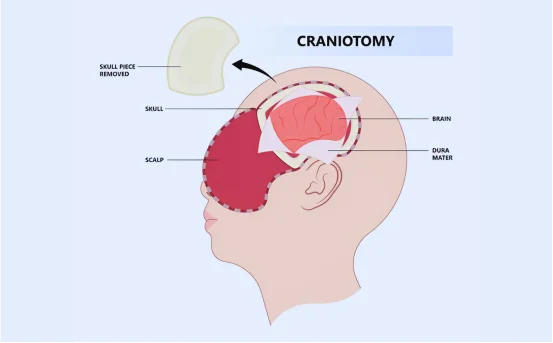Hearing that you or a loved one needs brain surgery can be overwhelming. One of the most frequently performed procedures in neurosurgery is called a craniotomy. While the word may sound intimidating, understanding what it means, why it’s done, and what to expect can help ease anxiety and prepare you for the journey ahead.
A craniotomy is not a one-size-fits-all operation. It’s a surgical approach used to treat a variety of conditions affecting the brain, from tumors and blood clots to aneurysms and traumatic injuries. The goal is to safely access the brain to treat the underlying problem while protecting critical brain function.
What is Craniotomy Surgery?
A craniotomy is a type of brain surgery where a section of the skull, known as a bone flap, is temporarily removed to allow the surgeon access to the brain. Once the procedure is complete whether it’s removing a tumor, draining fluid, or repairing a blood vessel the bone flap is usually secured back in place with small plates and screws.
The term “craniotomy” refers to the surgical technique itself, not the specific condition being treated. The exact location, size, and approach of the opening depend on the problem inside the brain and its position.
Why is Craniotomy Surgery Performed?
Craniotomy surgery is used to treat a wide range of neurological conditions, including:
- Brain tumors (benign or malignant)
- Traumatic brain injuries with bleeding or swelling
- Aneurysms or arteriovenous malformations (AVMs)
- Brain abscesses or infections
- Hydrocephalus (excess fluid in the brain)
- Epilepsy surgery in some cases
- Stroke or bleeding in the brain (hemorrhagic stroke)
Sometimes, a craniotomy is also performed for diagnostic purposes, such as collecting a biopsy from a brain lesion.
How is the Surgery Performed?
Craniotomy surgery is carried out under general anesthesia, meaning the patient is asleep and does not feel pain. In certain cases especially when the tumor is near critical areas like speech or motor control awake craniotomy may be done. In this approach, the patient is awake during parts of the procedure, allowing the surgical team to test and protect important brain functions in real-time.
The surgeon begins by shaving a small area of the scalp and making an incision. The bone flap is carefully removed to expose the brain. Depending on the condition being treated, the surgeon may remove a tumor, repair blood vessels, relieve pressure, or take a biopsy. After completing the procedure, the bone flap is replaced, and the scalp is closed with sutures or staples.
Risks and Recovery
Like any major surgery, a craniotomy carries certain risks. These may include infection, bleeding, brain swelling, seizures, or changes in memory, vision, or movement especially if the surgery involves areas responsible for these functions.
Recovery varies widely depending on the complexity of the surgery and the patient’s overall health. Some people return home within a few days, while others may need extended hospital care and rehabilitation. Common short-term effects include headaches, fatigue, and temporary confusion, but many patients recover well with time, rest, and supportive care.
Life After Craniotomy
Recovery from a craniotomy doesn’t end when you leave the hospital. It often involves follow-up scans, physical therapy, medication (such as anti-seizure drugs), and ongoing support from your medical team. Most patients can return to normal activities within a few weeks to months, though timelines can vary.
Staying in touch with your doctor, recognizing warning signs like severe headaches or new neurological symptoms, and maintaining a healthy lifestyle can all support a smooth recovery.
Conclusion
A craniotomy is a critical tool in modern neurosurgery, offering access to the brain to treat life-threatening or disabling conditions. While it may sound daunting, advances in surgical techniques, imaging, and monitoring have made this procedure much safer and more precise than ever before.
Understanding what craniotomy surgery involves why it’s done, how it’s performed, and what recovery looks like can make the process less frightening and more manageable. With the right care, many people go on to live full, active lives after surgery.























